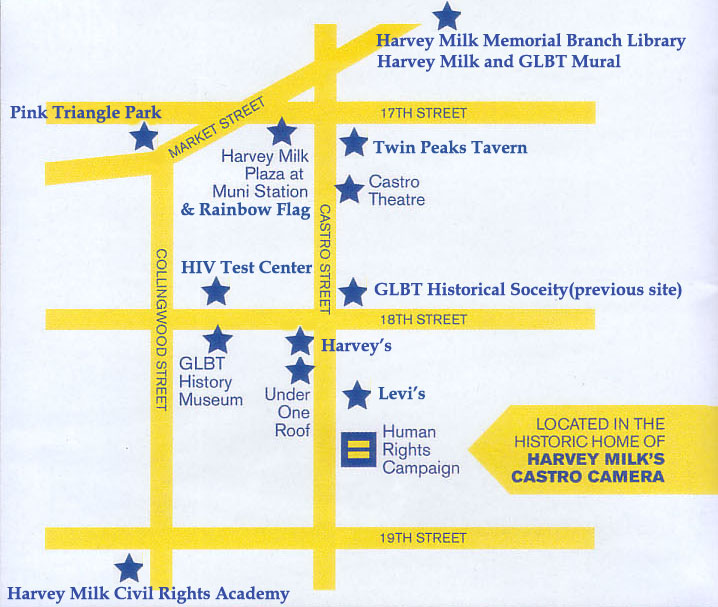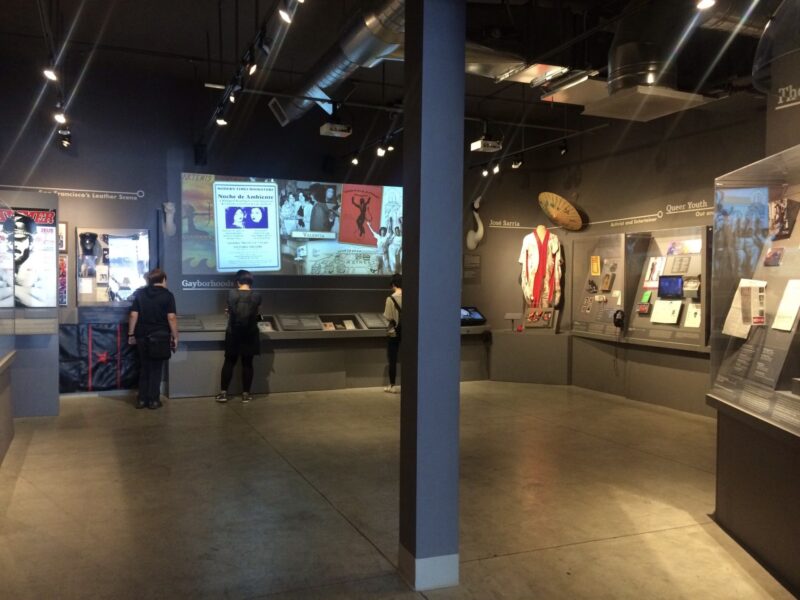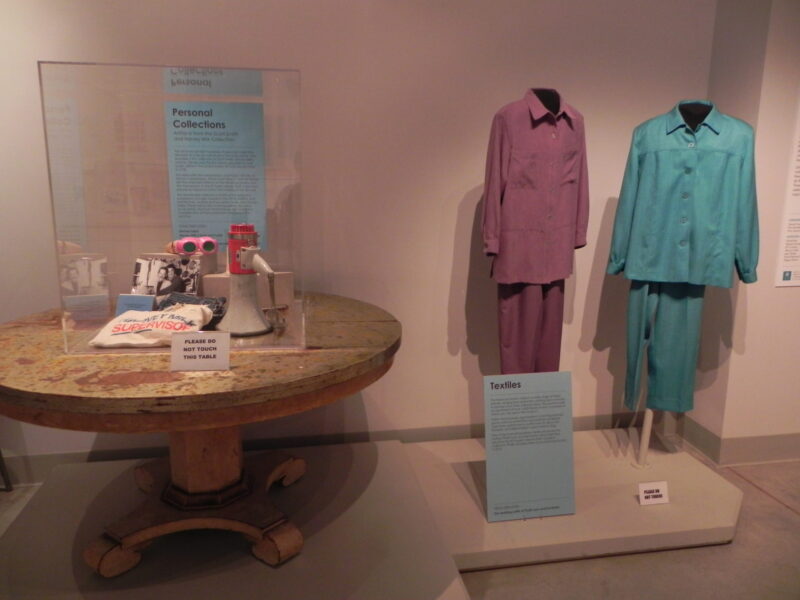Two groups of objects of Harvey Milk & Scott Smith and Phyllis Lyon & Del Martin are displayed side by side as great collection samples. (photo by Chun-Yun Wu)
Author: Chun-Yun Wu (MA, Graduate Institute of Museum Studies, Taipei National University of the Arts)
The GLBT History Museum, located in Castro Street, San Francisco, USA, is known as the “Queer Smithsonian”. It has a collection of historical materials about sexual minorities in North America since the beginning of the 20th century. The article begins with a return to the permanent exhibition in Castro Street in 2011, the first year of its opening, to explore how this institution, which contains the historical materials of sexual minority, becomes a queer museum. How does exhibiting queer trigger the original community’s balancing between visibility and diversity of internal differences?
Keywords: exhibiting queer, LGBT, history museum, visibility, diversity
Being Queer: GLBT History Museum
Opened in Castro Street, San Francisco in 2011, the first four initials of the name stand for “gay, lesbian, bisexual andtransgender”, and it is a museum dedicated to the history of the sexual minority in North America. The museum’s venue was set up this year to celebrate the 25th anniversary of the GLBT Historical Society. The museum, located on 18th Street between Castro Street and Collingwood Street, is the heart of Castro Street, and the birthplace of Harvey Milk’s political career in the movie Milk.
The choice of the GLBT History Museum to be located in Castro has the meaning of “returning to the heart of the city”. Milkcalled himself “the Mayor of Castro Street”, and won the election to become a San Francisco supervisor. Due to his public gay identity, advocacy for gay rights, and Milk’s good political propaganda, Castro became the “gay capital” of the USA in the late 1970s. However, the early murder of Milk, and the fierce AIDS epidemic in 1980s, made Castro Street bear the trace of sexual minority fighting for life and death here. The return of the museum has also become one of the views of sexual minority heritage on this street (Figure 1).

The opening of the permanent exhibition directly pointed out that the outbreak of Acquired Immunodeficiency Syndrome (AIDS) was closely related to the establishment of the GLBT Historical Society. The original collection was inspired by the fear of death and, more importantly, the disappearance of one’s own history, triggered by AIDS to sexual minority communities.
The society was founded in 1985 by a small group of historians and (social) activists, which was the culmination, standardization and expansion period of early work of collecting queer historic materials. This motivation came from the past when we lost our community due to the mass death of the epidemic HIV.…
–The first permanent exhibition in 2011 “Great Collections from the GLBT Historical Society Archives”
At the beginning of the large-scale outbreak of AIDS in San Francisco, there was no corresponding medical research and medical prescription. The American society initially treated AIDS with the targeted and stigmatized name of “Gay Cancer” and “GRID”(Gay-related immune deficiency). The government did not actively help the patients, which led to nationwide HIV/AIDS activism to fight against it, such as “the AIDS Memorial Quilt” started in 1985, and “the AIDS Coalition to Unleash Power (ACT UP)” founded in 1987. These collections, created by the impact of AIDS, were closely linked to nationwide AIDS campaigns in the 1980s and were baptized into queer history materials by queer studies.
The abbreviation of the museum’s name GLBT, which stands not for LGBT as it is today, is in the order of the emergence and naming of the G, L, B, T sexual community in “the course of history”, the exhibition contents in the museum are called “our queer,” which is also known as “Queer Smithsonian”. Queer studies, which began in the early 1990s, relate to a research field of gender re-reflection on the research landscape of feminism, LGBT studies, and post-structuralism that had developed over the previous two decades. Therefore, the GLBT History Museum, an intersection of history and queer studies, focuses not only on the tragic hero Harvey Milk, but also on the unknown, more marginal and oppressed sexual minority stories through historical materials.
Construct Queer: Queer’s Challenges and Responses
The permanent exhibition area of the GLBT History Museum is divided into the front gallery, “Great Collections from the GLBT Historical Society Archives”, and the main gallery, “Our Vast Queer Past: Celebrating San Francisco’s GLBT History” (Figure 2). The earliest objects in the collection date back to the early 20th century, when three curators, Gerard Koskovich and Don Romesburg, two gay men, and Amy Sueyoshi, a lesbian of Japanese descent, used all the collections to show the centennial history of queer in Northern California.

“Creating the Gay Vote: José Sarria’s 1961 Run for San Francisco Supervisor”, a small display area in the front gallery held prior to the exhibition, showcased the earliest sexual minorities running for office, in response to the ongoing San Francisco mayoral election in November 2011. At the end of the front gallery, between the two exhibition areas, a round table space is used to display the belongings of Harvey Milk and his partner, Scott Smith. Milk was assassinated in November 1978. His prerecorded last words, “political manifesto”, were reproduced in his original voice in the exhibition hall in November, Milk’s month of commemoration. Alongside the Milk Round Table exhibition area are the wedding dresses of the lesbian couple, Phyllis Lyon and Del Martin.
The discussion on the main gallery presentation pointed out what strategies should be adopted to present different queer people based on the internal differences of queer:
Our goal is to ask new questions about familiar gay, lesbian, bisexual and transgender stories, and inspire many stories that remain untold but have meaningful relevance to our diversity.
–The first permanent exhibition in 2011 “Our Vast Queer Past: Celebrating San Francisco’s GLBT History”
It takes questions, revelations and diversity as exhibition concepts, instead of displaying and narrating by historical stages or Chronicles. The front gallery displays the selective objects of collection types, while the main gallery displays in the form of thematic or biographical units.
Interestingly, the museum, presented with “our queer” as the first person (group), does not focus on reinforcing the respectiveidentity of GLBT or constructing the concept of “queer” as a we-group with vague distinctions, but rather acknowledges the differences, even addressing issues of gender politics and body politics. “Queer” is not a well-defined community, but a concept that was tried to be classified by academics in the 1990s. Throughout history, each community has maintained its own initiative, and there are even contradictions among them. Many themes on display at the exhibition show the validity of queer studies, which takes a position not in constructing a single, essential identity, but in deconstructing the homogeneity of identity. However, does it make sense for viewers not to read the queer museum in terms of identity, gender politics or the pursuit of equal citizenship?
In fact, such a strategy may have a more realistic view of queer life, not only queer as a social aspect of the oppressed, but also its challenge and response to the contemporary American society:
- Queer life experience: Life conditions being denounced because of ethnicity, class, occupation, old age, illness, obesity, poverty, or “queer bullying” and state violence.
- Queer rebelliousness: Queer goes beyond social conventions to engage in sexual activities such as leather BDSM, transgender, dress up, sex toys, pornography and bath house dating. The wisdom and technology generated for resistance, such as taking the path of art, gathering the strength of grass-roots movements in the bar life, feminist debate on pornographic media, stepping out of the dark cabinet and walking into the street, opposing the military’s “no questions, no answers” policy, refusing to be beaten on the road of personal violence, and even standing up against the government’s state violence of ignoring AIDS.
From these two perspectives, how to empathize and how to respond to challenges is a possible perspective. It is impossible to construct a single queer identity, and this dilemma is reflected in the narration of the exhibition.
Exhibit Queer: Balancing between “Visibility” and “Diversity”
The front gallery is a rectangular linear space that displays the collection types, not chronicling queer history or historical stages, but presenting it via samples, without a narrative that follows historical time. While the main gallery is a thematic exhibition, with approximately equal intervals between exhibition cabinets and surrounded by the layout of the exhibition space. Such spatial configuration also makes the diachronic exhibition difficult to occur.
To highlight the importance of display objects, it depends on whether the objects gain the advantages in space, lighting, illustration, color planning and other technologies, thus stacking the visibility of the exhibits. Located to the left of the front gallery entrance and displayed under the “spotlight” are objects of Harvey Milk and his partner Scott Smith, and nearby wedding dresses of Phyllis Lyon and Del Martin, who are two famous historic couples, at the end of the exhibition area of “Collection Types” of the front gallery. Compared with other different types of elective objects of collections, these two groups of objects have a dominant position in spatial vision. The similarity between the two groups of objects lies in the fact that both protagonists are “gay/lesbian couples” who have made important achievements in the pursuit of equality. Interestingly, rather than interpreting objects with titles such as “Milk’s Political Life” or “the Cool Wedding of Phyllis Lyon and Del Martin”, the two groups of display titles lowered the visibility of their stories respectively with descriptions of “personal collections” and “textiles” in the display structure (Figure 3).

In queer history, whether an individual or a group can be identified as “visibility” is of great significance in itself, such as coming out as a sexual minority or naming an identity (Note 2). Therefore, the advantages and disadvantages of visibility between such objects are crucial in the exhibition. Sueyoshi, a lesbian curator, understood that other gay curators wanted to show more of Milk’sobjects, but she believed that the Milk memorial site and deeds displayed in the block outside the museum were enough, and it was unnecessary to overemphasize in the museum. Whether more Milk’s objects should be added to the display depends on whether other objects can gain greater visibility advantages. The final result of negotiation was that the amount of Milk’s objects has not increased. In addition to revealing the differences between gay and lesbian views, the discussion on Milk’s visibility reveals, more accurately, that the viewers’ perception of “exhibit queer” is a political blueprint for visibility presented by the museum’s original community after internal consultation.
The museum attempts to reveal the hidden history and the task of valuing diversity to “anonymously deal with” the historicfamous gay/lesbian partners in the form of labels of collection types. On the other hand, the main gallery exhibition area tries to present a story that is as different from the Castro Street memorial site and historical narrative as possible, revealing the history that is difficult to speak about or has not been discussed in the past. These “hidden” or “present” attempts make hidden stories (unspoken or unseen in the past) visible, while concealing the sharpness of striking stories. In other words, the balancing of visibility revolves around the “hidden” or “present” adjustment mechanism. Due to the task of enriching queer history, the museum is faced with the choice of “who should be seen?” in its curatorial practice. Such a non-linear, non-sequenced and concerted effort has also created a sense of ambiguity and drift in the exhibition space, echoing with the unique nature of queer history.
Notes:
- The oldest gay restaurant, “Twin Peaks Tavern”, is operated locally, and through the large glass, it can be seen that most of the diners in and out the restaurant are old gay men, which is mockingly called “glass coffin” by the locals. The Castro Theater hosted the world’s first gay film festival in 1977, the precursor of San Francisco International LGBT Film Festival today. Besides North America, African-American and South Asian LGBT films are also included.
- The current sexual minority identities developed in North America at least include L.G.B.T.T.T.I.Q.Q (lesbian, gay, bisexual, transgender, transsexual, two-spirit, intersex, queer and questioning), which have been differentiated by different sexual orientation, sexual appearance and sexual practice, and their names continue to be differentiated to this day.
References:
- 吳淳畇(2015)。身體觀的展演:舊金山卡斯楚GLBT歷史博物館(Exhibiting and Performing the Notions of Body: Gay, Lesbian, Bisexual, Transgender History Museum in Castro, San Francisco)。臺北市:國立臺北藝術大學博物館研究所碩士論文。
- Boyd, N. (2003). Wide-Open Town: A History of Queer San Francisco to 1965. Berkeley and Los Angeles: University of California Press.
- Conlan, A. (2010). Representing Possibility: Mourning, Memorial, and Queer Museology. In: Levin, A. L. (Ed.), Gender, Sexuality and Museums: A Routledge Reader, 253-263. New York: Routledge.
- Shilts, R. (2008). The Mayor of Castro Street: the Life and Times of Harvey Milk. New York: St. Martin’s Griffin.
- Stein, M. (Ed.) (2004). LGBT, Encyclopedia of Lesbian, Gay, Bisexual, and Transgender History in America. New York: Thomson/Gale.

